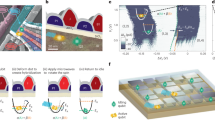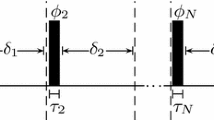Abstract
Explicit controlled-NOT gate sequences between two qubits of different types are presented in view of applications for large-scale quantum computation. Here, the building blocks for such composite systems are qubits based on the electrostatically confined electronic spin in semiconductor quantum dots. For each system the effective Hamiltonian models expressed by only exchange interactions between pair of electrons are exploited in two different geometrical configurations. A numerical genetic algorithm that takes into account the realistic physical parameters involved is adopted. Gate operations are addressed by modulating the tunneling barriers and the energy offsets between different couple of quantum dots. Gate infidelities are calculated considering limitations due to unideal control of gate sequence pulses, hyperfine interaction and charge noise.









Similar content being viewed by others
References
Medford, J., Beil, J., Taylor, J.M., Bartlett, S.D., Doherty, A.C., Rashba, E.I., DiVincenzo, D.P., Lu, H., Gossard, A.C., Marcus, C.M.: Self-consistent measurement and state tomography of an exchange-only spin qubit. Nat. Nanotechnol. 8, 654 (2013)
Koppens, F.H.L., Buizert, C., Tielrooij, K.J., Vink, I.T., Nowack, K.C., Meunier, T., Kouwenhoven, L.P., Vandersypen, L.M.K.: Driven coherent oscillations of a single electron spin in a quantum dot. Nature (London) 442, 766 (2006)
Petta, J.R., Johnson, A.C., Taylor, J.M., Laird, E.A., Yacoby, A., Lukin, M.D., Marcus, C.M., Hanson, M.P., Gossard, A.C.: Coherent manipulation of coupled electron spins in semiconductor quantum dots. Science 309, 2180 (2005)
Veldhorst, M., Hwang, J.C.C., Yang, C.H., Leenstra, A.W., de Ronde, B., Dehollain, J.P., Muhonen, J.T., Hudson, F.E., Itoh, K.M., Morello, A., Dzurak, A.S.: An addressable quantum dot qubit with fault-tolerant control-fidelity. Nat. Nanotechnol. 9, 981 (2014)
Kawakami, E., Scarlino, P., Ward, D.R., Braakman, F.R., Savage, D.E., Lagally, M.G., Friesen, M., Coppersmith, S.N., Eriksson, M.A., Vandersypen, L.M.K.: Electrical control of a long-lived spin qubit in a Si/SiGe quantum dot. Nat. Nanotechnol. 9, 666 (2014)
Maune, B.M., Borselli, M.G., Huang, B., Ladd, T.D., Deelman, P.W., Holabird, K.S., Kiselev, A.A., Alvarado-Rodriguez, I., Ross, R.S., Schmitz, A.E., Sokolich, M., Watson, C.A., Gyure, M.F., Hunter, A.T.: Coherent singlet-triplet oscillations in a silicon-based double quantum dot. Nature 481, 344 (2012)
Morton, J.J.L., McCamey, D.R., Eriksson, M.A., Lyon, S.A.: Embracing the quantum limit in silicon computing. Nature 479, 345 (2011)
Levy, J.: Universal quantum computation with spin-1/2 pairs and Heisenberg exchange. Phys. Rev. Lett. 89, 147902 (2002)
Shi, Z., Simmons, C.B., Prance, J.R., Gamble, J.K., Koh, T.S., Shim, Y.P., Hu, X., Savage, D.E., Lagally, M.G., Eriksson, M.A., Friesen, M., Coppersmith, S.N.: Fast hybrid silicon double-quantum-dot qubit. Phys. Rev. Lett. 108, 140503 (2012)
Loss, D., DiVincenzo, D.P.: Quantum computation with quantum dots. Phys. Rev. A 57, 120 (1998)
DiVincenzo, D.P., Bacon, D., Kempe, J., Burkard, G., Whaley, K.B.: Universal quantum computation with the exchange interaction. Nature (London) 408, 339 (2000)
Mehl, S., Bluhm, H., DiVincenzo, D.P.: Two-qubit couplings of singlet-triplet qubits mediated by one quantum state. Phys. Rev. B 90, 045404 (2014)
Doherty, A.C., Wardrop, M.P.: Two-qubit gates for resonant exchange qubits. Phys. Rev. Lett. 111, 050503 (2013)
Veldhorst, M., Yang, C.H., Hwang, J.C.C., Huang, W., Dehollain, J.P., Muhonen, J.T., Simmons, S., Laucht, A., Hudson, F.E., Itoh, K.M., Morello, A., Dzurak, A.S., Two, A.: Qubit logic gate in silicon. Nature (London) 526, 410 (2015)
Mehl, S., DiVincenzo, D.P.: Simple operation sequences to couple and interchange quantum information between spin qubits of different kinds. Phys. Rev. B 92, 115448 (2015)
Nakajima, T., Delbecq, M.R., Otsuka, T., Amaha, S., Yoneda, J., Noiri, A., Takeda, K., Allison, G., Ludwig, A., Wieck, A.D., Tarucha, S.: Phase control of local and non-local entanglement in a triple spin qubit. arXiv:1604.02232 (2016)
Koh, T.S., Gamble, J.K., Friesen, M., Eriksson, M.A., Coppersmith, S.N.: Pulse-gated quantum-dot hybrid qubit. Phys. Rev. Lett. 109, 250503 (2012)
Kim, D., Shi, Z., Simmons, C.B., Ward, D.R., Prance, J.R., Koh, T.S., Gamble, J.K., Savage, D.E., Lagally, M.G., Friesen, M., Coppersmith, S.N., Eriksson, M.A.: Quantum control and process tomography of a semiconductor quantum dot hybrid qubit. Nature 511, 70 (2014)
Kim, D., Ward, D.R., Simmons, C.B., Savage, D.E., Lagally, M.G., Friesen, M., Coppersmith, S.N., Eriksson, M.A.: High-fidelity resonant gating of a silicon-based quantum dot hybrid qubit. Npj Quantum Inf. 1, 15004 (2015)
Wu, X., Ward, D.R., Prance, J.R., Kim, D., Gamble, J.K., Mohr, R.T., Shi, Z., Savage, D.E., Lagally, M.G., Friesen, M., Coppersmith, S.N., Eriksson, M.A.: Two-axis control of a singlettriplet qubit with an integrated micromagnet. PNAS 111, 11938–11942 (2014)
Barnes, E., Rudner, M.S., Martins, F., Malinowski, F.K., Marcus, C.M., Kuemmeth, F.: Filter function formalism beyond pure dephasing and non-Markovian noise in singlet-triplet qubits. Phys. Rev. B 93, 121407(R) (2016)
Pioro-Ladrière, M., Obata, T., Tokura, Y., Shin, Y.S., Kubo, T., Yoshida, K., Taniyama, T., Tarucha, S.: Electrically driven single-electron spin resonance in a slanting Zeeman field. Nat. Phys. 4, 776 (2008)
Gonzalez-Zalba, M., Barraud, S., Ferguson, A., Betz, A.: Probing the limits of gate-based charge sensing. Nat. Commun. 6, 6084 (2014)
Ferraro, E., De Michielis, M., Mazzeo, G., Fanciulli, M., Prati, E.: Effective Hamiltonian for the hybrid double quantum dot qubit. Quantum Inf. Process. 13, 1155 (2014)
Ferraro, E., De Michielis, M., Fanciulli, M., Prati, E.: Effective Hamiltonian for two interacting double-dot exchange-only qubits and their controlled-NOT operations. Quantum Inf. Process. 14, 47 (2015)
De Michielis, M., Ferraro, E., Fanciulli, M., Prati, E.: Universal set of quantum gates for double-dot exchange-only spin qubits with intradot coupling. J. Phys. A Math. Theor. 48, 065304 (2015)
Ferraro, E., De Michielis, M., Fanciulli, M., Prati, E.: Coherent tunneling by adiabatic passage of an exchange-only spin qubit in a double quantum dot chain. Phys. Rev. B 91, 075435 (2015)
Rotta, D., De Michielis, M., Ferraro, E., Fanciulli, M., Prati, E.: Maximum density of quantum information in a scalable CMOS implementation of the hybrid qubit architecture. Quantum Inf. Process. Top. Collection 15, 2253 (2016)
Fong, B.H., Wandzura, S.M.: Universal quantum computation and leakage reduction in the 3-qubit decoherence free subsystem. Quantum Inf. Comput. 11, 1003 (2011)
Yuan, H., Khaneja, N.: Time optimal control of coupled qubits under nonstationary interactions. Phys. Rev. A 72, 040301 (2005)
Khaneja, N., Brockett, R., Glaser, S.J.: Time optimal control of coupled qubits under nonstationary interactions. Phys. Rev. A 63, 032308 (2001)
Yoneda, J., Otsuka, T., Nakajima, T., Takakura, T., Obata, T., Pioro-Ladrire, M., Lu, H., Palmstrm, C.J., Gossard, A.C., Tarucha, S.: Fast electrical control of single electron spins in quantum dots with vanishing influence from nuclear spins. Phys. Rev. Lett. 113, 267601 (2014)
Neumann, R., Schreiber, L.R.: Simulation of micro-magnet stray-field dynamics for spin qubit manipulation. J. Appl. Phys. 117, 193903 (2015)
Nielsen, M.A., Chuang, I.L.: Quantum Computation and Quantum Information. Cambridge University Press, Cambridge (2000)
Marinescu, D.C., Marinescu, G.M.: Classical and Quantum Information. Elsevier, Amsterdam (2012)
Mehl, S.: Two-qubit pulse gate for the three-electron double quantum dot qubit. Phys. Rev. B 91, 035430 (2015)
Taylor, J.M., Petta, J.R., Johnson, A.C., Yacoby, A., Marcus, C.M., Lukin, M.D.: Relaxation, dephasing, and quantum control of electron spins in double quantum dots. Phys. Rev. B 76, 035315 (2007)
Assali, L.V.C., Petrilli, H.M., Capaz, R.B., Koiller, B., Hu, X., Das Sarma, S.: Hyperfine interactions in silicon quantum dots. Phys. Rev. B 83, 165301 (2011)
Testolin, M.J., Cole, J.H., Hollenberg, L.C.L.: Modeling two-spin dynamics in a noisy environment. Phys. Rev. A 80, 042326 (2009)
Möttönen, M., de Sousa, R., Zhang, J., Whaley, K.B.: High-fidelity one-qubit operations under random telegraph noise. Phys. Rev. A 73, 022332 (2006)
Arbitrary Waveform Generators: AWG70000A Series Datasheet. http://www.tek.com/datasheet/awg70000a-arbitrary-waveform-generator-datasheet
Schrieffer, J.R., Wolff, P.A.: Relation between the Anderson and Kondo Hamiltonians. Phys. Rev. 149, 491 (1966)
Acknowledgements
This project has received funding from the European Union’s Horizon 2020 research and innovation programme under Grant Agreement No. 688539.
Author information
Authors and Affiliations
Corresponding author
Appendices
Appendix A: Effective exchange coupling constants
In this Appendix, following the same procedure already exploited in Refs. [24, 25], all the detailed expressions for the exchange coupling constants between pair of electrons in both the mixed architectures considered are reported. The Schrieffer–Wolff effective Hamiltonian models (5) and (11) are derived by combining a Hubbard-like model with a projector operator method [42]. As a result, the Hubbard-like Hamiltonian is transformed into an equivalent expression in terms of the exchange coupling interactions between pairs of electrons. Since the two dots composing the hybrid qubit are asymmetric, it follows that there are two different possible configurations for each architecture as shown in Figs. 1 and 4.
1.1 Quantum dot single-spin qubit and double quantum dot hybrid qubit
The expressions for the exchange coupling constants for the configuration A appearing in the effective Hamiltonian (5) are given by
with the energy differences defined as
where
The first index in parenthesis \(w=0,1\) denotes the electron occupation for the single-spin qubit L, while the indices \(i,j,k=0,1,2\) denote the number of electrons in each level for the hybrid qubit R ordered as depicted in Fig. 1. The parameters involved are: the energy levels \(\varepsilon _i\), the tunneling coefficients between different dots \(t_{ij}\), the spin exchange \(J_e^{ij}\) and the occupation-modulation hopping terms \(J_t^{ij}\).
Analogously the exchange coupling constants for the configuration B are defined as in Eq. (18) with the new inter-qubit interaction
where \(\Delta E_5=E_{(0,112)}-E_{(1,111)}\). The energies corresponding to each configurations are given for the configuration B by
1.2 Double quantum dot singlet–triplet qubit and double quantum dot hybrid qubit
The exchange coupling constants for the double QD singlet–triplet and the double QD hybrid qubits in configuration A appearing in the effective Hamiltonian (11) are given by
where
with
The first (last) indices inside parenthesis, assuming only integer values between 0 and 2, denote the number of electrons in each level for qubit L(R) ordered as depicted in Fig. 4.
For the configuration B the coupling constants are defined as in Eq. (23) with the new inter-qubit interaction
where \(\Delta E_5=E_{(10,121)}-E_{(11,111)}\). The energies are now given by
Appendix B: Graphical representation of CNOT gates
In this Appendix a graphical representation of modulus and phase (gray scale) of the final transformation matrix for the CNOT gates for the four mixed architectures studied is shown (Fig. 10). The resulting transformation matrices are obtained starting from the sequences reported in Figs. 2, 3, 5 and 6. The \(4\times 4\) block in the up left corner corresponds to the CNOT matrix reported in Eq. (9).
Rights and permissions
About this article
Cite this article
Ferraro, E., Fanciulli, M. & De Michielis, M. Controlled-NOT gate sequences for mixed spin qubit architectures in a noisy environment. Quantum Inf Process 16, 277 (2017). https://doi.org/10.1007/s11128-017-1729-1
Received:
Accepted:
Published:
DOI: https://doi.org/10.1007/s11128-017-1729-1





